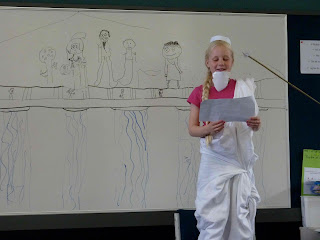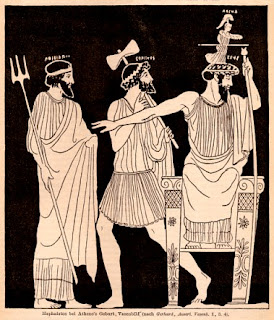MONDAY
On Monday we did some inquiry learning about Ancient Greek
architecture. We learnt about the
different types of columns (Doric, Ionic, and Corinthian), friezes, metopes and
triglyphs, and pediments. Then we
did some detailed study of the most famous building on the Acropolis, The
Parthenon. We looked at the layout
of the Parthenon, the types of columns (Doric on the outside and Ionic on the
inside), the metope/triglyph frieze, and the stories sculpted in the pediments: the
contest for Athens on the West and the birth of Athena on the East. We looked at how the frieze around the
building showed a Panathenaic Procession and the offering of the peplos robe to
Athena (we knew about the Panathenaic Games from our earlier study and this was
the procession that was held at the opening of these games). And we already knew all about the 12
metre high gold and ivory statue of Athena inside the Parthenon!
Then we talked about how we would set up our next drama
play, which was going to be the opening of the Parthenon in 438BC. We made a collective plan about who
would be at the opening and what events might happen. Then everyone chose what parts they would like to play and
started to prepare their roles. It
was decided that there would be a table of gods watching the opening, a
restaurant on Mt Olympis serving the gods, speeches by Pericles (the leader of
Athens) and Phidias (the sculptor), entertainers, traders, and townspeople with
offerings for Athena.
 |
Preparing roles.
 |
| Erin shows everyone how it took 9 years to build The Parthenon - working in BC time can be tricky! |
|
WEDNESDAY
This was the last day of our Mantle of the Expert Ancient
Greece unit.
We began the day looking at architectural features of modern
day buildings in Wellington that have been influenced by the artists and
designers of Ancient Greece in the Golden Age. We saw Doric columns on the Railway Station, Ionic columns
on the Parliament buildings, Corinthian columns on the town hall, and Doric
columns and pediments on St Andrews on the Terrace. We even saw one building that had a triglyph and metope
frieze around the top.
 |
| Doric columns on the Wellington Railway Station |
 |
| Corinthian columns on the Wellington Town Hall |
We then spent the morning finishing our preparations for the
opening of the Parthenon. Costumes
and props were organised and the room layed out as the area around the
Parthenon. The whiteboard was the front of the Parthenon and the columns,
metope/triglyph frieze, and pediment showing the contest for Athens between
Athena and Poseidon was drawn.
 |
| Drawing the Parthenon |
THE OPENING OF THE PARTHENON
Once everything was prepared we used circular drama to watch
all the different things that were happening as part of the opening of the
Parthenon. First we listened to
conversations between the townspeople who had come to see the new building.
 |
| Two women who have come to see the opening of the Parthenon. |
“I have bought a sack of obols for Athena and jars of olive
oil” (these were presented to a very pleased Athena, Poseidon was not happy!).
“Isn’t it wonderful! Did you bring the sacrifices?” (a number of chickens and sheep were presented to Athena!).
Then we heard speeches from Pericles and Phidias officially
opening the Parthenon, watched over by guards.
 |
| Pericles officially opens The Parthenon. |
“Hello loyal citizens.
Today we are here for the opening of the Parthenon. Today we need to thank some people.
First of all we would like to give great thanks to Phidias the great man who
built this wonderful building.
Second of all we would like to thank the wonderful designers Kalamis,
Ictinus, and Calibrates. Thirdly I
would like to thank all of you for agreeing to build this wonderful
building. Finally I would like to
thank the beautiful goddess Athena for being the god of Athens and in your
honour we have built a twelve metre statue of you! We have tried to make this the most beautiful building in
Athens and hope you like it. Thank
you.” PERICLES
“I’m honoured to be here to present the Parthenon with our
12 metre gold statue of Athena. We
love our goddess Athena …we may have to keep away from Poseidon today
though….!” [note: because he
didn’t win the contest for Athens!]. PHIDIAS
Then we watched the gods for a while feasting at the Mt
Olympus restaurant ‘Gods Olympus’.
They were talking about the new building and Athena was very happy about
the huge statue they had made of her.
Hermes carried messages between the gods and Poseidon was very grumpy at
all the celebrating of Athena (since he had lost the contest for Athens) and moodily
ate his shrimp!
 |
| Serving the gods at the restaurant 'Gods Olympus'. |
 |
| Athena and Poseidon |
Finally we watched entertainers perform music, songs, and
dances. Everyone got tickets to
the wonderful performance by BAGS (Bennet, Abigail, Georgie, and Samantha).
 |
| BAGS entertains |
When we had taken turns to watch the different activities we
had time for some free play in the scene.
The gods came down in disguises to Athens to participate in trading and
watching the entertainments, and everyone admired the new building. There was a
lot of creativity in the play today and the children showed they had learnt a
lot!
THE BIG DIG
After lunch everyone chose one friend to come and spend the afternoon as archaeologists. We had 30 squares to dig in today all filled with artifacts that we have studied throughout our unit of work. The Mantle children told their friend as much as they could about each artifact they dug up. They shared their toolkits and archaeological log books with their friend and showed them all about working in role.
 |
| Our dig site! |
 |
| The dig begins. |
In each square there was also one quiz question about the
Golden Age of Ancient Greece. The
winners of this quiz were….LEON and LACHLAN (you can collect your choc fish
from Mrs Skilton tomorrow – well done!).
PRIZEGIVING
To celebrate the end of our unit of work we had a
prizegiving. We did this with all
of our friends there to watch.
Everyone received a certificate, their storymaps of the Odyssey, their
logbooks, and their toolkits to take home. Well done everyone, it has been lots of fun and I am very
impressed with how much you have all learnt about the Golden Age of Ancient
Greece, Homer’s Odyssey, and archaeology – you have all become real experts!
REFLECTIONS
We also did some reflection work today. Here are some favourite moments and comments about Mantle of the Expert this term.
“I love Mantle and I would love to be chosen again. I loved every week of it. I also thought it was very fun. I think I know more that my mum now.”
 |
| "I loved it when we were doing the play of the Parthenon opening. I was Athena!" |
 |
| "My favourite moment was the slave trade." |
 |
| "My favourite thing was doing clay" |
 |
| "I think that Mantle has been really fun and I would love to do it again" |
 |
| “I like Mantle of the Expert. I like this way of learning. It helps me remember things and it’s a fun way of learning. I think I learnt lots. I would love to be chosen for Mantle of the Experts again next year.” |
 |
| "I love all the art, drama, and writing. I learned LOADS about Ancient Greece. I wish I could keep doing Mantle until Yr 8.” |
 |
| "I wish Mantle was going for ever and ever and ever. I hope I get chosen again" |




































